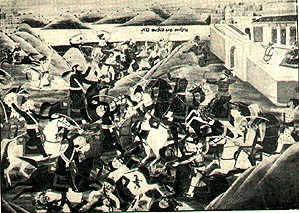Siege of Anandpur:
They hence rallied under the leadership of the Raja of Bilaspur, in whose territory lay Anandpur, to forcibly evict Guru Gobind Singh from his hilly citadel. Their repeated expeditions during 1700-04 however proved abortive. The Khalsa forces were too strong to be dealt with by the hill Rajas. They at last petitioned Emperor Aurangzeb for help. In concert with contingents sent under imperial orders by the governor of Lahore and those of the faujdar of Sirhind, they marched upon Anandpur and laid a siege to the fort in May 1705.
Over the months, the Guru and his Sikhs firmly withstood their successive assaults despite insufficient amounts of food resulting from the prolonged blockade. While the besieged (Sikhs) were reduced to desperate straits, the besiegers (governor of Lahore) too were exhausted at the courage of the Sikhs. At this stage the besiegers offered, on Oath (promise) of the Qur'an, safe exit to the Sikhs if they quit Anandpur. At last, the town was evacuated during a night of December 1705. But as the Guru and his Sikhs came out, the hill monarchs and their Mughal allies set upon them in full fury.
They hence rallied under the leadership of the Raja of Bilaspur, in whose territory lay Anandpur, to forcibly evict Guru Gobind Singh from his hilly citadel. Their repeated expeditions during 1700-04 however proved abortive. The Khalsa forces were too strong to be dealt with by the hill Rajas. They at last petitioned Emperor Aurangzeb for help. In concert with contingents sent under imperial orders by the governor of Lahore and those of the faujdar of Sirhind, they marched upon Anandpur and laid a siege to the fort in May 1705.
Over the months, the Guru and his Sikhs firmly withstood their successive assaults despite insufficient amounts of food resulting from the prolonged blockade. While the besieged (Sikhs) were reduced to desperate straits, the besiegers (governor of Lahore) too were exhausted at the courage of the Sikhs. At this stage the besiegers offered, on Oath (promise) of the Qur'an, safe exit to the Sikhs if they quit Anandpur. At last, the town was evacuated during a night of December 1705. But as the Guru and his Sikhs came out, the hill monarchs and their Mughal allies set upon them in full fury.
Siege of Anandpur:
They hence rallied under the leadership of the Raja of Bilaspur, in whose territory lay Anandpur, to forcibly evict Guru Gobind Singh from his hilly citadel. Their repeated expeditions during 1700-04 however proved abortive. The Khalsa forces were too strong to be dealt with by the hill Rajas. They at last petitioned Emperor Aurangzeb for help. In concert with contingents sent under imperial orders by the governor of Lahore and those of the faujdar of Sirhind, they marched upon Anandpur and laid a siege to the fort in May 1705.
Over the months, the Guru and his Sikhs firmly withstood their successive assaults despite insufficient amounts of food resulting from the prolonged blockade. While the besieged (Sikhs) were reduced to desperate straits, the besiegers (governor of Lahore) too were exhausted at the courage of the Sikhs. At this stage the besiegers offered, on Oath (promise) of the Qur'an, safe exit to the Sikhs if they quit Anandpur. At last, the town was evacuated during a night of December 1705. But as the Guru and his Sikhs came out, the hill monarchs and their Mughal allies set upon them in full fury.
0 Comments
0 Shares
0 Reviews




